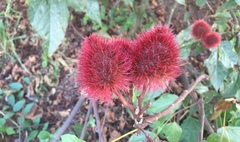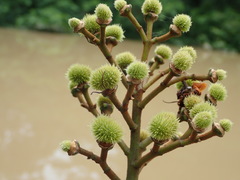
Neotropical Flora
|
Family: Bixaceae
[Bixa odorata Ruiz & Pav. ex G. Don] |
Shrub or small tree, 1.5-8 (15) m tall; trunk to 10 (15) cm dbh; branchlets reddish-brown. Stipules narrowly ovate, ca 1 cm long, caducous; petioles slender, 2-10 (14) cm long, slightly enlarged at apex; blades ovate or ovate-lanceolate, acuminate, rounded to truncate or cordate at base, 5-27 cm long, 3-18 cm wide, glabrous or sparsely lepidote above, densely lepidote below, the scales minute, reddish-brown; palmate veins at base 5. Panicles terminal, variable in size, mostly 5-15 cm long; inflorescence branches, pedicels, and calyces densely reddish-brown-lepidote outside; pedicels to 1 cm long, with 5 conspicuous glands below calyx; sepals 5, orbicular, ca 1 cm diam, concave; petals 5, obovate, 2-3 cm long, l-2 cm wide, white (rarely pinkish); stamens many, 1-1.5 cm long; filaments slender, white, glabrous; anthers yellow, horseshoe-shaped, 1-1.5 mm long; ovary globose to pyriform, densely to sparsely bristly; style 1-1.5 cm long. Capsules variable in size, shape, and indument throughout the species' range, usually +/- globose to ovoid, 1.5-4.5 cm long, brown to red, with sparse to dense, short, flexible spines; seeds many, +/- irregular, red, ca 5 mm long, the testa fleshy. Croat 7875,12294. Occasional, along the shore. Flowers from September to February (sometimes from August). The fruits mature from January to June, with old dehisced capsules hanging on as late as September. In Costa Rica bees are the most common visitors and presumed pollinators, especially Eulaema (D. Janzen, pers. comm.), Xylocopa, Trigona, and Melipona (Heithaus, 1973). In Ecuador the flowers are visited by female Eulaema cingulata, E. polychroma, E. homichlora, and E. meriana for pollen (Dodson & Frymire, 1961). A red condiment and cosmetic is obtained from the seeds (Duke, 1968). |
|
|
|
Powered by Symbiota.















































































